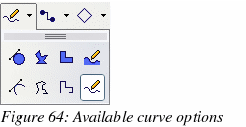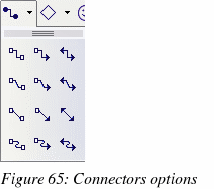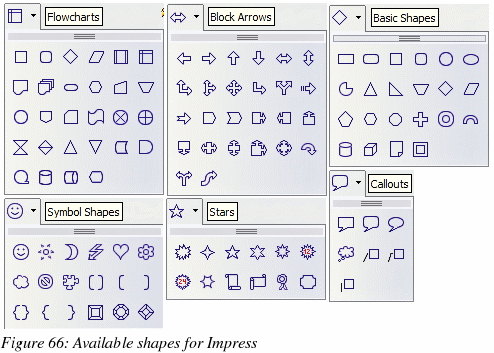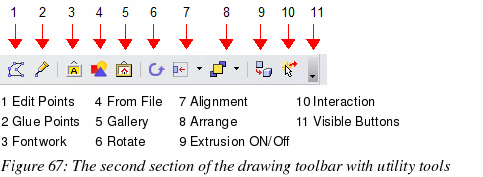|
 |
|
| |
The Drawing toolbar
The
Drawing toolbar collects the majority of the tools normally used to
create graphic objects. If this
toolbar is not showing, select View >
Toolbars >
Drawing from the main menu
bar.

The
toolbar can be divided into two parts. The first part contains
drawing objects, as shown in Figure 63. The tools in this part of
the Drawing toolbar are:
Select:
selects objects. To select multiple objects click on the top
leftmost object and while keeping the mouse button pressed, drag
the mouse to the bottom rightmost object of the intended selection.
A marching ants rectangle identifying the selection area is
displayed. It is also possible to select several objects by
pressing the Control
button while selecting the individual objects.
Line:
draws a straight line.
Arrow:
draws a straight line ending with an arrowhead. The arrowhead will
be placed where you release the mouse button.
Rectangle:
draws a rectangle. Press the Shift
button to draw a square.
Ellipse:
draws an ellipse. Press the Shift
button to draw a circle.
Text:
creates a text box with text aligned horizontally.
Vertical
text: creates a text box with text aligned vertically.
This tool is available only when Asian language support has been
enabled in Tools >
Options > Language Settings > Languages.
Curve:
draws a curve. Click the black triangle for more options, shown in
Figure 64. Note that the title of the submenu when undocked is
Lines.

Connectors:
draws a connector line between two figures. Click the black
triangle for additional connectors, shown in Figure 65. The use of
connectors is described in “Working with connectors“ on page 99.

Basic
Shapes, Symbol
Shapes, Block
Arrows, Flowcharts,
Callouts, Stars:
click the black triangle to open a toolbar showing the available
shapes in that category. The default shapes are shown in Figure 66.
Select the desired shape, then draw as normal. Keep the Shift
key pressed to obtain a shape where the height and width are equal.

The second part of
the toolbar, shown in Figure 67, contains more generic tools.

Those
tools are:
Edit
points: select this tool, then select a shape or a line,
to edit the individual points that form the shape or line.
Glue
points: select this tool to edit the glue points of a
graphic object. Glue points are the positions where connector lines
terminate or start. See “Managing glue points” on page 100 for
instructions.
Fontwork:
opens the Fontworks gallery. See “Using Fontwork” on page 113
for further information.
From
file: equivalent to Insert
> Picture > From file on the main menu. See
Chapter 4 for details.
Gallery:
opens the gallery. Equivalent to Tools
> Gallery on the main menu. See Chapter 4 for
details.
Rotate:
select this tool to rotate an object. As rotation is considered a
formatting attribute, this is discussed in chapter 6 of this book.
Align
object: see “Aligning shapes“ on page 105.
Arrange
object: see “Arranging shapes“ on page 104.
Extrusion
On/Off: switches 3D effects on or off for the selected
object. Clicking this button also opens the 3D settings toolbar.
See “Working with 3D shapes” on page 101 for details.
Interaction:
opens a dialog where you can specify the interaction between the
user and the object. See “Setting up interaction with a shape or image”
on page 109.
Visible
buttons: use the black triangle to open a menu that
allows to add or subtract buttons to the toolbar. The step by step
procedure is given in Chapter 4 of the Getting
Started guide.
|
|
|
